Chapter: Civil : Railway Airport Harbour Engineering : Railway Engineering : Sleepers
Cast Iron Sleepers
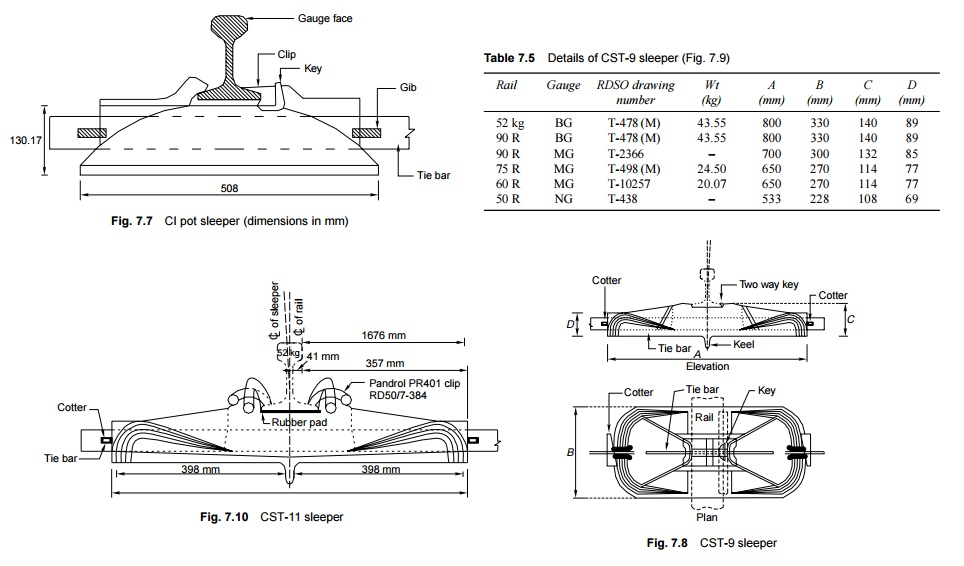
Cast Iron Sleepers
Cast iron sleepers are being
extensively used on Indian Railways and about 45% of the track at present
consists of CI sleepers, which may be either pot type or plate type. The main
advantages and disadvantages of CI sleepers over steel trough sleepers are the
following.
Advantages
(a) Less
corrosion
(b) Less
probability of cracking at rail seat
(c) Easy to
manufacture
(d) Higher
scrap value
Disadvantages
(a) Gauge
maintenance is difficult as tie bars get bent
(b) Provides
less lateral stability
(c) Unsuitable
for track-circuited lines
(d) Not very
suitable for mechanical maintenance and/or MSP because of rounded bottom
(e) Susceptible
to breakage
CI pot sleepers
Cast iron pot sleepers (Fig. 7.7) consist of two hollow bowls
or pots of circular or elliptical shape placed inverted on the ballast section.
The two pots are connected by a tie bar with the help of cotters and gibs; the
gauge can be adjusted slightly [± 3 mm (1/8")] by changing their
positions. The rail is placed on top of the pots in a rail seat provided with a
cant of 1 in 20 and is held in position with the help of a key. The pot sleeper
suffers from the drawback that it cannot be used on curves sharper than 4 o on
BG. Most of the fittings are hidden and their inspection and maintenance is
quite difficult. These sleepers have become obsolete now and are not being
procured by the Indian Railways any more.
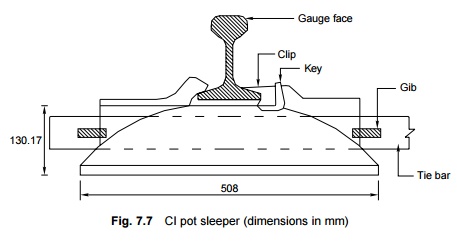
CST-9 sleepers
The CST-9 sleeper is a standard sleeper and is being most
extensively used on Indian Railways (IR). It is called CST-9 (Central Standard
Trial-9) (Fig. 7.8) because it is the ninth of the series produced by the
Central Standard Office. The sleeper is a combination of pot, plate, and box
sleepers. It consists of two triangular inverted pots on either side of the
rail seat, a central plate with a projected keel, and a box on top of the
plate. The two CI plates are connected by a tie bar with the help of four
cotters. The rails are held to the sleeper by two-way keys provided at each
rail seat on the side of the gauge face. The gauge is adjusted to a value of ±
5 mm by altering the relative positions of the four cotters.
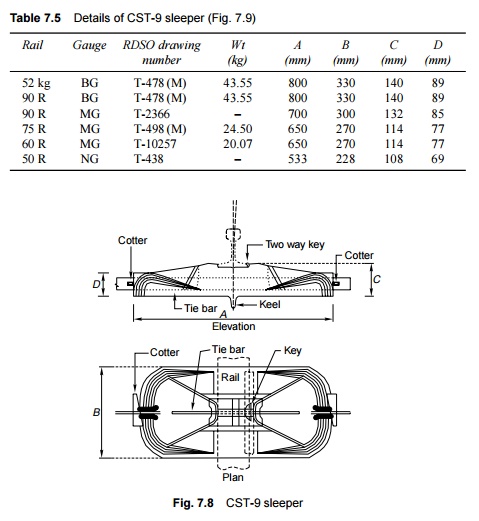
The rail seat of a CST-9 sleeper
is 115 mm wide along the length, and this narrow bearing tends to reduce the
rocking of the sleeper under the wave motion of the rail. The sleeper is
designed to provide a firm support to the rail and provides fairly good lateral
and longitudinal stability to the rails. The dimensions of CST sleepers in use
on IR are given in Table 7.5. The sleeper provides a bearing area approximately
equal to the effective bearing area of a standard BG wooden sleeper, i.e., 5
sq. ft, for both the plates. CST-9 plates are also available with reverse jaws
(T-443 type) to serve as an anti-sabotage measure; a few of these are provided
in each rail length. Normally, three reverse jaw CST-9 sleepers are provided
per rail to serve anti-sabotage purposes. The weight of a CST-9 sleeper
assembly along with fastenings for BG is 102 kg and for MG is 58 kg.
The CST-9 sleeper is one of the most popular sleepers on
Indian Railways at present. The sleeper has, however, certain limitations when
combined with the modern track as mentioned in the following.
(a) As the
sleeper does not have a flat bottom, it is not quite suitable for MSP and
mechanical maintenance with tie tamers.
(b) The
suitability of a CST-9 sleeper on LWRs, particularly on the breathing lengths,
is doubtful because of rigid fastenings and the inability of the fastenings to
hold the rail with a constant toe load.
(c) The rail
seat wears out quickly causing the keys to come loose.
(d) The
sleeper has only limited longitudinal and lateral strength to hold LWRs,
particularly in the breathing length.
(e) Due to
the use of less metal under rail seat, the shocks and vibrations are directly
transmitted to the ballast, resulting in poor retention of packing (loose
packing) and hence an increased frequency of attention.
CST-9 sleeper for MG
A new design of the CST-9 sleeper
has recently been developed by Indian Railways for 90 R rails on MG lines as
shown in Fig. 7.9.
CST-10 sleepers
The CST-10 sleeper is an
improvement on the design of the CST-9 sleeper to suit the requirements of a
modern track. The basic design feature of this sleeper is the same as that of a
CST-9 sleeper except the following improvements.
(a) The rail
is held with clips and double-coil spring washers instead of a fixed lug and
key.
(b) An
insulating liner is provided between the rail and the sleeper.
(c) A rubber
pad is provided below the rail seat.
A CST-10 sleeper gives certain
amount of elasticity to the track by virtue of its double-coil spring washer.
The sleeper, however, has the limitation that it cannot be used with elastic
fastenings.
CST-11 sleepers
The CST-11 sleeper is an
improvement over the CST-10 sleeper. A special shoulder is provided to
accommodate the Pandrol clip instead of clips and double-coil spring washers.
An elastic rubber pad is provided between the sleeper and the rail seat instead
of the rail resting directly on the sleeper. The CST-11 sleeper has the
potential of being used on the modern track. The sleeper, however, is still in
the experimental stage and the results are not very encouraging at present. Its
design details are shown in Fig. 7.10.
CST-12 sleepers
CST-12 sleepers are designed to
suit the IRN-202 clip, instead of the Pandrol clip. In this case the casting is
quite complicated due to the shape of the clip. No firm has undertaken the
manufacture of this sleeper as yet.
CST-13 sleepers
The purpose of the CST-13 sleeper is to use the existing CST-9
sleeper with certain additions and alternations made in the local workshop. It
consists of the CST-9.
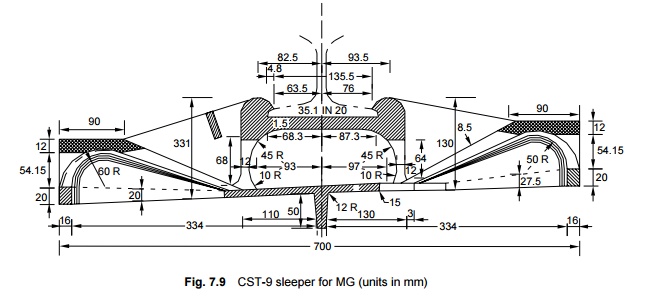
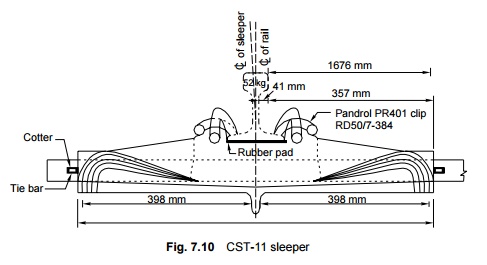
plate with the rubber pad under
the rail and an additional rubber head to fill the gap occupied by the key. The
rail is fastened to the sleeper by a sigma clip, similar to the 'fist
fastening' used on Swedish Railways. To reduce the cost of the sleeper, the
inner cotter is dispensed with. No adjustment of gauge is possible in this
sleeper. The CST-13 sleeper is still under trial.
Related Topics